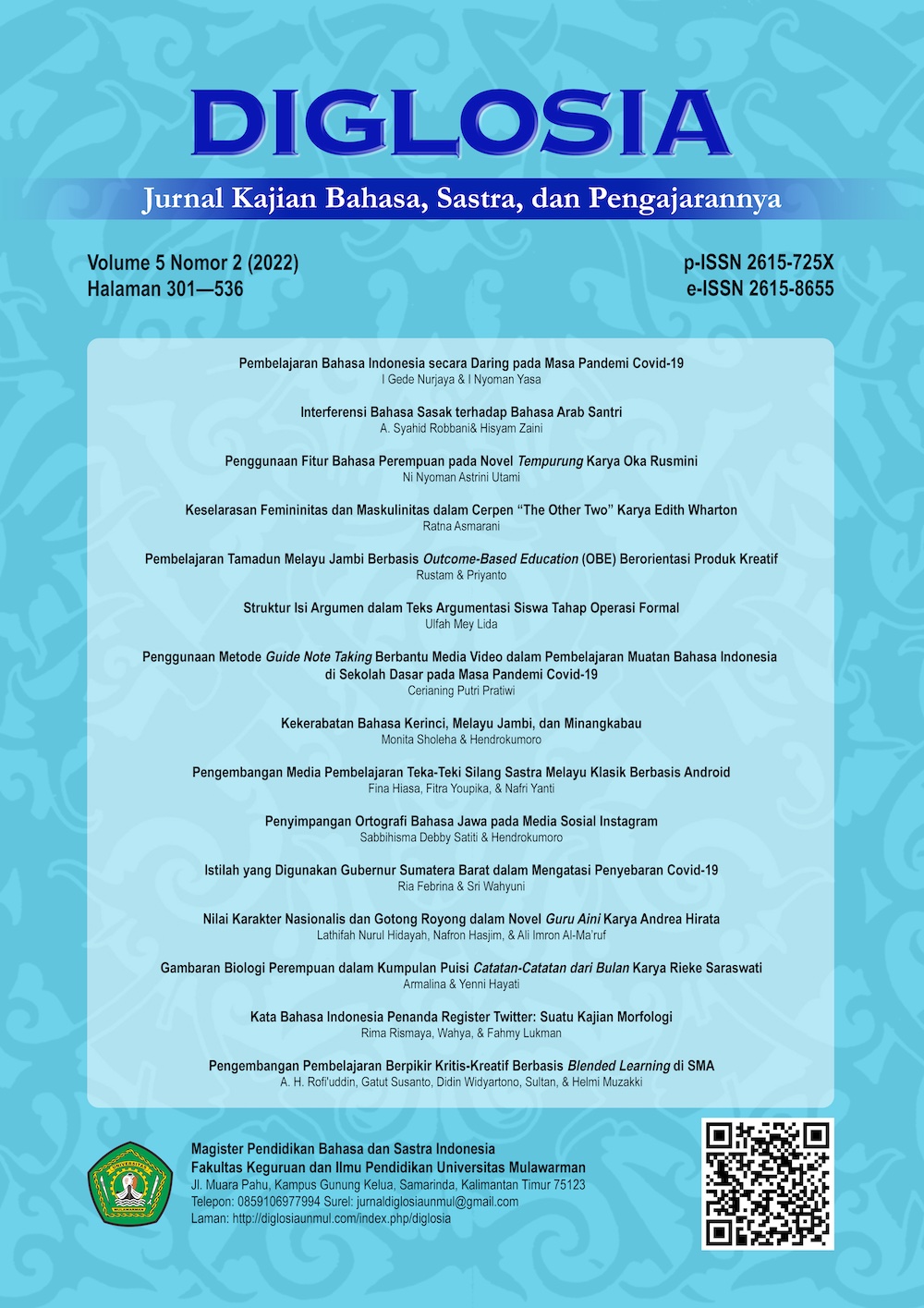Struktur Isi Argumen dalam Teks Argumentasi Siswa Tahap Operasi Formal Argument Content Structure in Student Argumentation Text for Formal Operations Stage
Main Article Content
Abstract
Text is the embodiment of one's ideas in written language that can be read and understood by the reading community. Argumentation is basically an embodiment of discourse. This study was conducted to determine the structure of the argument content in the students' argumentative essays in the formal operation stage by describing the research findings. The approach used in this study is a qualitative approach with the Miles and Huberman analysis model. The data of this research is in the form of a fragment of the student's argumentative text. This data was obtained from students' assignments to write arguments their teachers had given. In collecting data, the method used is the method of listening. The techniques used are free listening and conversation, documentation, and note-taking. The data analysis of this research uses the communication content analysis model. Based on the analysis results, it was found that the structure of the argument content of the students in the formal operation stage consisted of four structures. The four content structures are (1) deductive complex content structure, (2) inductive complex content structure, (3) deductive simple content structure, and (4) deductive complex simple content structure.
Downloads
Article Details
![]()
Every work in Diglosia: Jurnal Kajian Bahasa, Sastra, dan Pengajarannya is licensed under a Creative Commons Attribution-ShareAlike 4.0 International License.
Under the following terms:
- Attribution — You must give appropriate credit , provide a link to the license, and indicate if changes were made . You may do so in any reasonable manner, but not in any way that suggests the licensor endorses you or your use.
- ShareAlike — If you remix, transform, or build upon the material, you must distribute your contributions under the same license as the original.
- No additional restrictions — You may not apply legal terms or technological measures that legally restrict others from doing anything the license permits.
Authors who publish with this journal agree to the following terms:
- Authors retain copyright and grant the journal right of first publication with the work simultaneously licensed under a CC BY-SA 4.0 DEED Attribution-ShareAlike 4.0 Internationalthat allows others to share the work with an acknowledgment of the work's authorship and initial publication in this journal.
- Authors are able to enter into separate, additional contractual arrangements for the non-exclusive distribution of the journal's published version of the work (e.g., post it to an institutional repository or publish it in a book), with an acknowledgment of its initial publication in this journal.
- Authors are permitted and encouraged to post their work online (e.g., in institutional repositories or on their website) prior to and during the submission process, as it can lead to productive exchanges, as well as earlier and greater citation of published work.
References
Basid, A., Kamil, H. I., & Innah, M. (2021). Struktur Kalimat pada Film Knives Out Berdasarkan Perspektif Tata Bahasa Kasus Charles J. Fillmore. Diglosia: Jurnal Kajian Bahasa, Sastra, Dan Pengajarannya, 4(3), 301–320. https://doi.org/10.30872/diglosia.v4i3.209
Bastow, D., Carney, J. D., & Scheer, R. K. (1966). Fundamentals of Logic. The Philosophical Quarterly, 16(65), 398. https://doi.org/10.2307/2218525
Bell, F. H. (1981). Teaching and Learning Mathematics (In Secondary School). United States of America: Wm. C. Brown Company Publishers.
Darwati, D., & Santoso, B. W. J. (2017). Pilihan Kode pada Wacana Konsultasi Siswa kepada Guru di SMK Ma’arif 4 Kebumen. Seloka, 6(1), 93–99. https://journal.unnes.ac.id/sju/index.php/seloka/article/view/14770
Holsti, O. (1969). Content Analysis for the Social Science and Humanities. Reading, Massachusetts: Addison – Westley Publishing.
Jarvis, M. (2017). Teori-Teori Psikologi: Pendekatan Modern untuk Memahami Perilaku, Perasaan & Pikiran Manusia. Malang: PENERBIT NUSA MEDIA.
Miles, M. B., & Huberman, M. A. (1984). Qualitative Data Analysis a Sourcebook of New Methode. London: Sage Publications.
Narimo, N., Santoso, A., Pratiwi, Y., & Mujianto, M. (2014). Proposisi dan Argumen Dalam Diskusi Kelas Siswa SMP. Program Studi Pendidikan Bahasa Indonesia. Pascasarjana. Universitas Negeri Malang.
Nursisto. (1999). Kiat Menggali Kreativitas. Yogyakarta: Mitra Gama Widya.
Septarianto, T. W., & Subyantoro. (2016). Pengembangan Buku Pengayaan Menulis Teks Laporan Hasil Observasi yang Bermuatan Kearifan Lokal untuk Peserta Didik Kelas X SMA. Seloka: Jurnal Pendidikan Bahasa Dan Sastra Indonesia, 5(2), 216–224. https://journal.unnes.ac.id/sju/index.php/seloka/article/view/13087
Sokhipah, W. L., & Mardikantoro, H. B. (2016). Keefektifan Model Show Not Tell dan Mind Map pada Pembelajaran Menulis Teks Eksposisi Berdasarkan Minat Peserta Didik Kelas X SMK. LINGUA, XII(1), 92–99. https://journal.unnes.ac.id/sju/index.php/seloka/article/view/9863
Sunarto, & Hartono, A. (2013). Perkembangan Peserta Didik. Jakarta: Rineka Cipta.
Syaifudin, A. (2012). Pengembangan Model Pembelajaran Menulis Argumentasi Siswa SMA Melalui Dukungan ICT. Jurnal Pendidikan Bahasa Dan Sastra Indonesia, 6(2), 41–44. https://journal.unnes.ac.id/sju/index.php/seloka/article/view/120
Wardani, L. S. P., & Sabardila, A. (2020). Kualitas Argumentasi Mahasiswa dalam Wacana Debat “Budaya Literasi Sekolah” pada Pembelajaran Keterampilan Berbahasa. Diglosia: Jurnal Kajian Bahasa, Sastra, Dan Pengajarannya, 3(3), 341–350. https://doi.org/10.30872/diglosia.v3i3.61

